Key takeaways:
- End-to-end encryption (E2EE) ensures only communicating users can read messages, enhancing privacy and security.
- Data privacy is a fundamental right, preventing identity theft and fostering trust in digital services.
- E2EE is widely used in messaging apps, file sharing, and email, providing essential security in communication.
- The future of E2EE includes advancements like quantum-resistant algorithms and greater transparency in encryption practices.
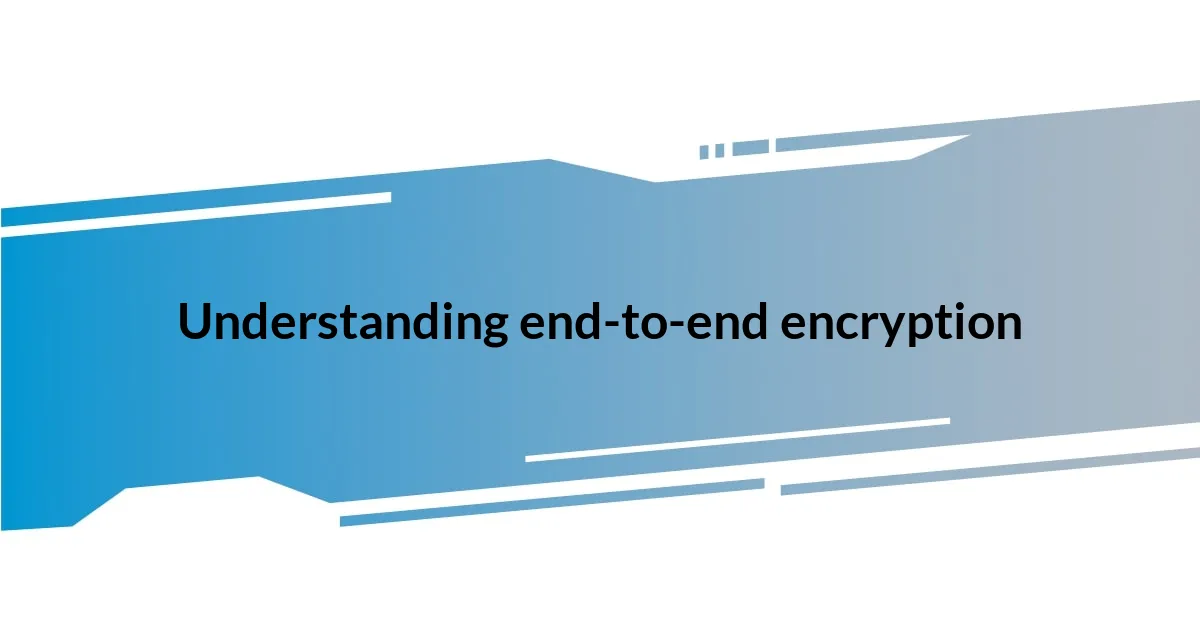
Understanding end-to-end encryption
End-to-end encryption (E2EE) is a method that ensures only the communicating users can read the messages they exchange. I remember when I first started using a messaging app that promised E2EE; it felt like unlocking a new level of privacy. Suddenly, my conversations felt more secure, and I found myself sharing thoughts without the fear of prying eyes.
At its core, E2EE works by encrypting data on the sender’s device and only decrypting it on the recipient’s device. This means that not even the service provider can access the content of the messages. Isn’t it comforting to think that, in a world where data breaches are common, your private chats can remain truly private? Personally, I’ve found that knowing this technology exists gives me peace of mind in an increasingly connected world.
However, while E2EE safeguards our conversations, it also poses challenges, especially for law enforcement trying to crack down on illegal activities. It raises a thought-provoking question: Should privacy always come before security? From my perspective, finding a balance between the two is critical, as E2EE empowers users but also invites debates on responsibility and safety.
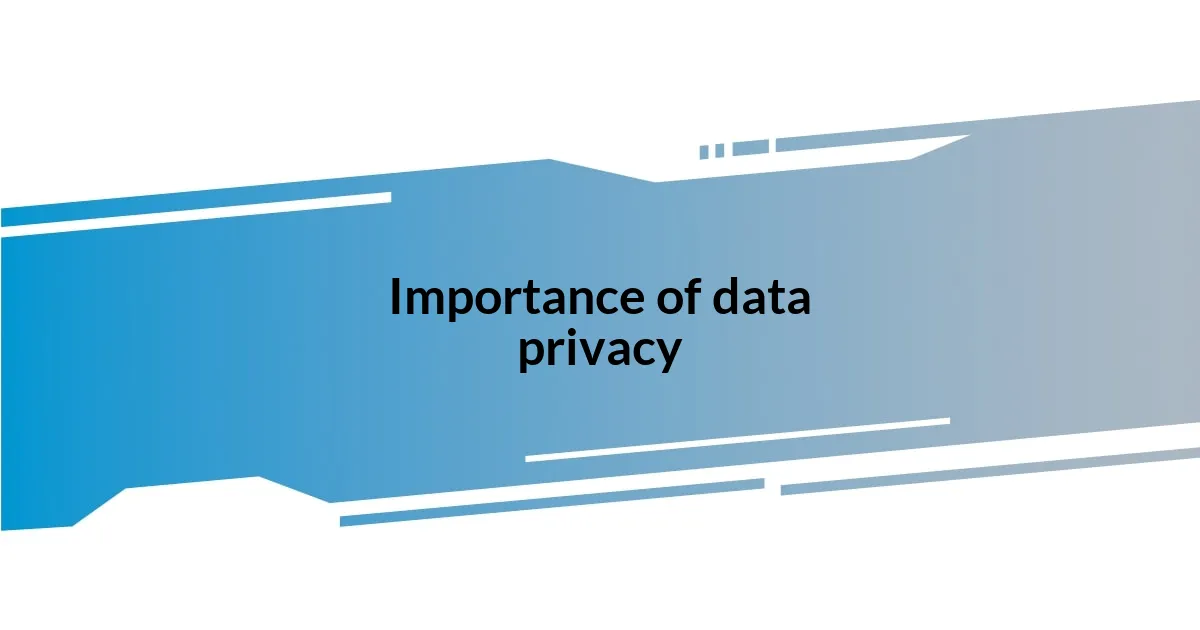
Importance of data privacy
Data privacy is not just a buzzword; it’s a fundamental right that underpins our digital lives. I can recall a time when I mistakenly shared some personal information online, thinking it was harmless. It was an eye-opener when I learned how easily that data could be misused. This experience reinforced my belief that we should protect our information with vigilance and knowledge.
Here are some key reasons why data privacy is essential:
- Protection from Identity Theft: Personal data can fuel identity theft, leading to financial loss and emotional distress.
- Control Over Personal Information: Maintaining data privacy means having the authority to decide who can see what about us.
- Trust and Safety: When people feel their data is secured, they are more likely to engage with digital services, fostering a safer online environment.
- Preservation of Freedom: Data privacy safeguards freedom of speech and allows individuals to express themselves without the fear of surveillance.
Every incident of data breach reminds me just how important it is for us to take charge of our online privacy. It’s a constant balance between sharing and protecting, and from my perspective, understanding this importance is crucial in today’s digital age.
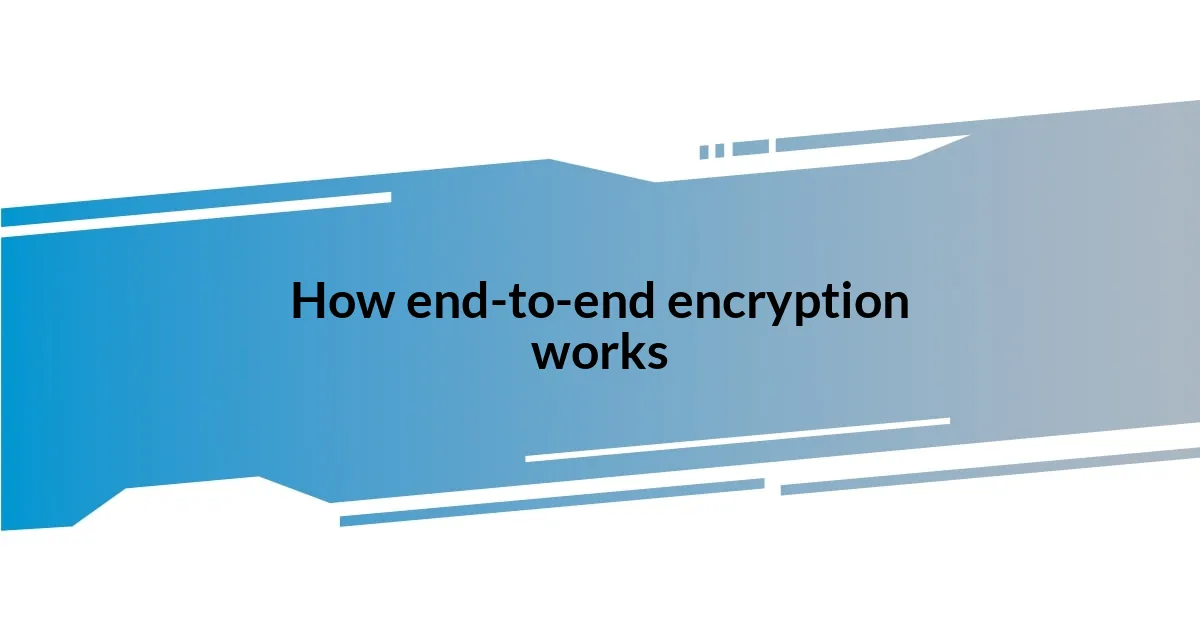
How end-to-end encryption works
End-to-end encryption functions through a sophisticated dance of keys and algorithms. When I send a message, it’s scrambled using an encryption key placed directly on my device, making it almost like sending a secret code. It’s fascinating to think that only the recipient, who holds the corresponding decryption key, can decipher that message. This process not only protects my words from anyone else but also ensures that even if the data gets intercepted, it remains indecipherable.
What I find intriguing is how this technology essentially puts the user in control. No one else—including the service provider—can access the message’s content during its journey. I experienced this firsthand when a friend shared sensitive information with me. Knowing that our chat could only be read by us really reinforced my belief in the power of E2EE. It felt liberating, almost like hiding a diary under my pillow that only I can unlock with a special key.
As I delve deeper into how E2EE operates, I can’t help but appreciate the complexities involved in ensuring secure communication. Encryption algorithms can differ in their methods and robustness, impacting the overall security. For instance, some use symmetric encryption, where the same key encrypts and decrypts, while others use asymmetric encryption, utilizing a pair of keys. This variety adds layers of security but also complexity. There was a moment when I was helping a family member set up a messaging app with E2EE; explaining these concepts made me realize how crucial it is for users to grasp the technology they use daily.
| Encryption Method | Key Characteristics |
|---|---|
| Symmetric Encryption | Same key for encryption and decryption, faster but requires secure key sharing. |
| Asymmetric Encryption | Uses a pair of keys (public and private), more secure but slower in processing. |
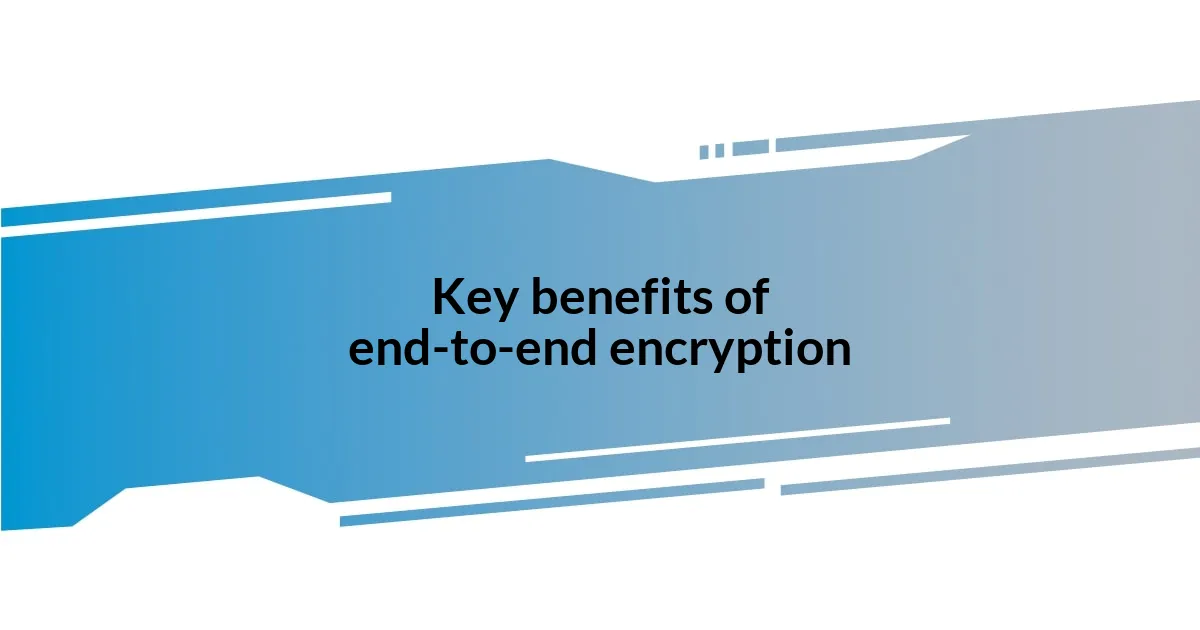
Key benefits of end-to-end encryption
End-to-end encryption offers a powerful shield for our private conversations. When I think back to a time when I was sharing sensitive details about a project with a colleague, the reassurance that the information was secured against prying eyes was priceless. This sense of security not only fosters open communication but also strengthens professional relationships, as we know our discussions are safe.
One of the standout benefits of E2EE is the peace of mind it provides. I’ll never forget the relief I felt when switching to a messaging app that I knew utilized this technology. With so much uncertainty in our digital world, having the confidence that my personal exchanges wouldn’t be accessible to hackers allowed me to relax and share without apprehension. Can you imagine what it would feel like to speak freely, knowing you’re completely shielded from unwanted ears?
Moreover, E2EE actively builds trust between users and service providers. I once opted for a service because they were transparent about their encryption practices. The knowledge that this company prioritized my privacy made me feel valued as a customer. In today’s landscape, where data breaches and spying are alarmingly common, isn’t it comforting to choose platforms that genuinely care for our security? It transforms the digital experience from mere transactions to meaningful interactions.
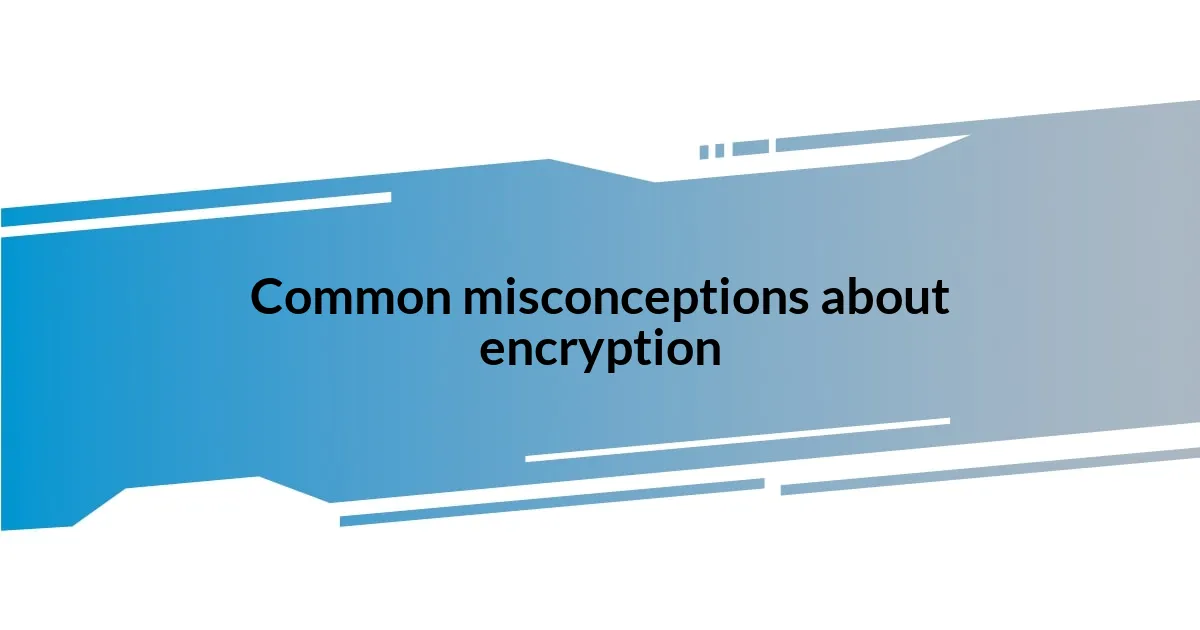
Common misconceptions about encryption
It’s often assumed that encryption guarantees absolute privacy, but that’s not entirely true. While encryption significantly enhances security, it doesn’t protect against user negligence, such as using weak passwords. I remember a colleague who shared sensitive files but used a simple password to secure them, highlighting the importance of combining encryption with strong access controls.
Another common misconception is that encryption is exclusively for tech-savvy users. In my experience, many apps with E2EE are designed with user-friendliness in mind. A few years back, I helped a less tech-inclined friend set up an encrypted messaging app. She was amazed at how straightforward it was, dispelling her initial fears of complexity. It just goes to show that with the right tools, anyone can communicate securely, regardless of their technical background.
Some people also believe that once data is encrypted, it can’t be hacked. Sadly, this is misleading. Encryption can be compromised if a hacker gains access to your device or if the encryption methods themselves have vulnerabilities. My own home was targeted by a phishing attempt once; luckily, I was cautious and didn’t click the link, sparing me from a potential breach. This experience taught me that being proactive about overall digital hygiene is just as crucial as relying on encryption alone.
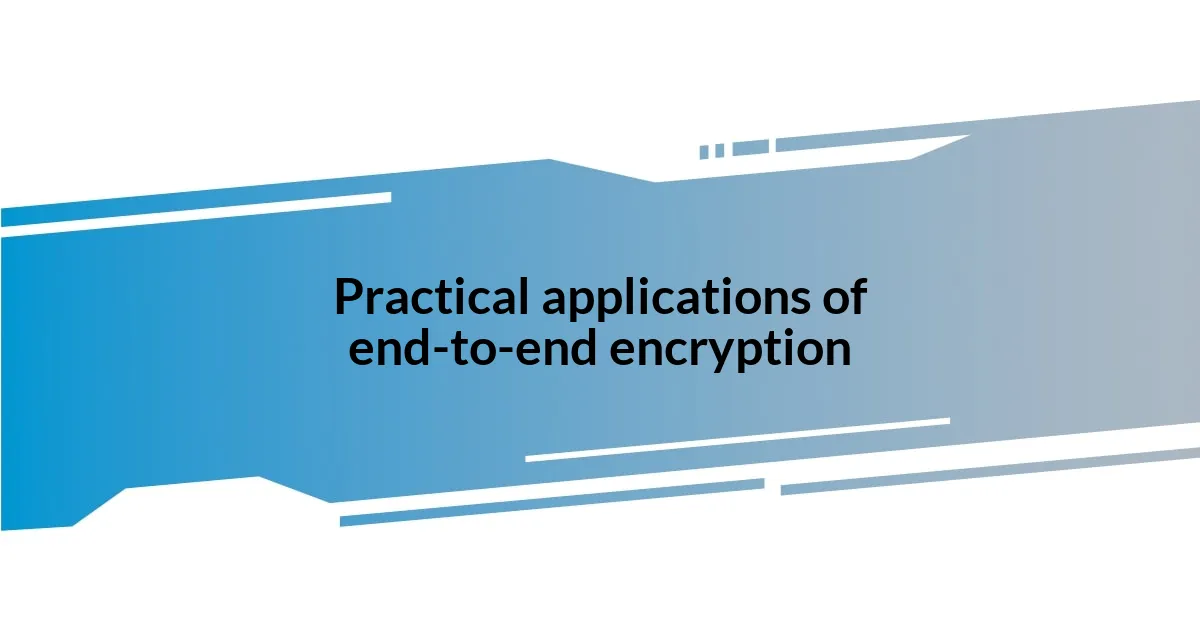
Practical applications of end-to-end encryption
End-to-end encryption is widely used in messaging platforms like Signal and WhatsApp, ensuring that only the intended recipients can read the messages. I remember the first time I started using an app like Signal; the immediate sense of security was striking. It felt liberating to know that even the company behind the app couldn’t access my conversations, allowing me to open up without worry.
Beyond messaging, E2EE is essential when sharing files or documents. I once collaborated on a project that required sending sensitive financial data. Utilizing a cloud service that employed end-to-end encryption gave me the confidence that our business information wouldn’t fall into the wrong hands. It’s incredible how technology can facilitate secure collaboration, right?
Even email services are now adopting end-to-end encryption. I recall transitioning to a platform that encrypted my emails, which made me reflective on how many private exchanges had previously been exposed. Isn’t it reassuring to think that with the right tools, our communications aren’t just out in the open for anyone to intercept? The peace of mind it provides is worth exploring these secure options further.
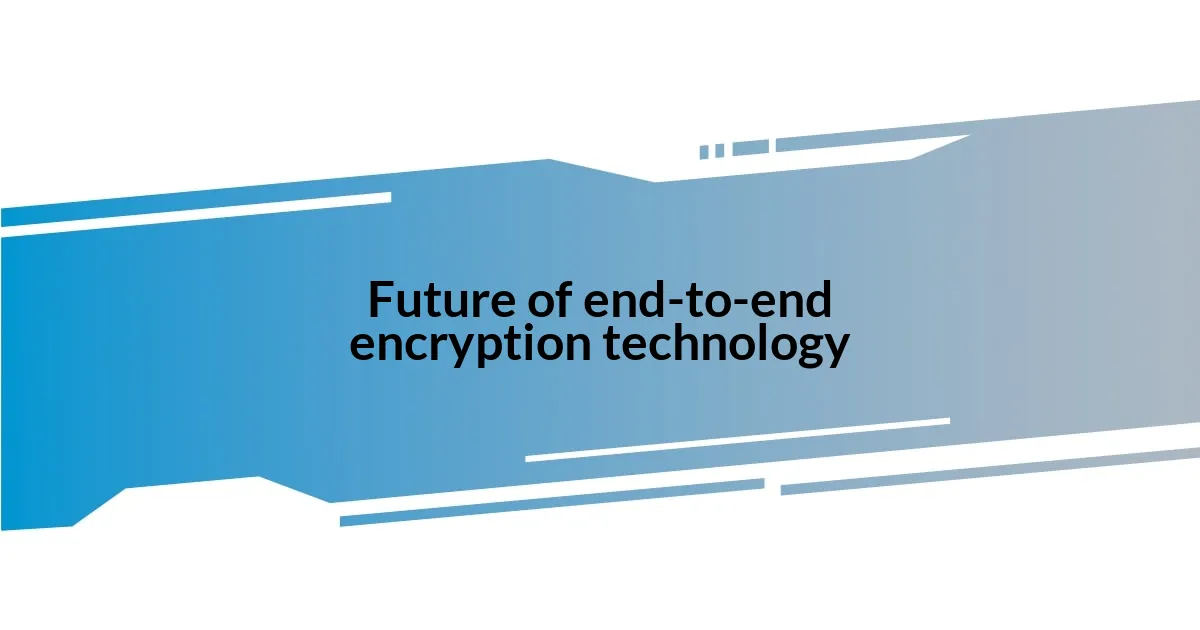
Future of end-to-end encryption technology
The future of end-to-end encryption technology looks promising, with ongoing advancements in security protocols. I often think about how the introduction of quantum-resistant algorithms could redefine what we consider secure communication. As we move into a world increasingly driven by data, these innovations will ensure that our conversations remain confidential, even against the most sophisticated threats.
In my conversations with industry experts, I’ve noticed a strong consensus: the need for greater transparency in encryption technology is paramount. It’s fascinating how companies are starting to realize that consumers want to know what protections are in place. This kind of awareness could lead to more robust security measures and encourage a culture where encryption is seen as essential, not optional. Can you imagine a day when the general public demands this level of clarity? I believe we’re already on that path.
Moreover, the integration of artificial intelligence with encryption technology could shape the future landscape. I had an eye-opening discussion recently about how AI could help detect and prevent potential breaches before they occur. It feels like we’re on the brink of a revolutionary shift, where proactive security measures become the norm. What an exciting time to be following these developments!